Full Text Searchable PDF User Manual
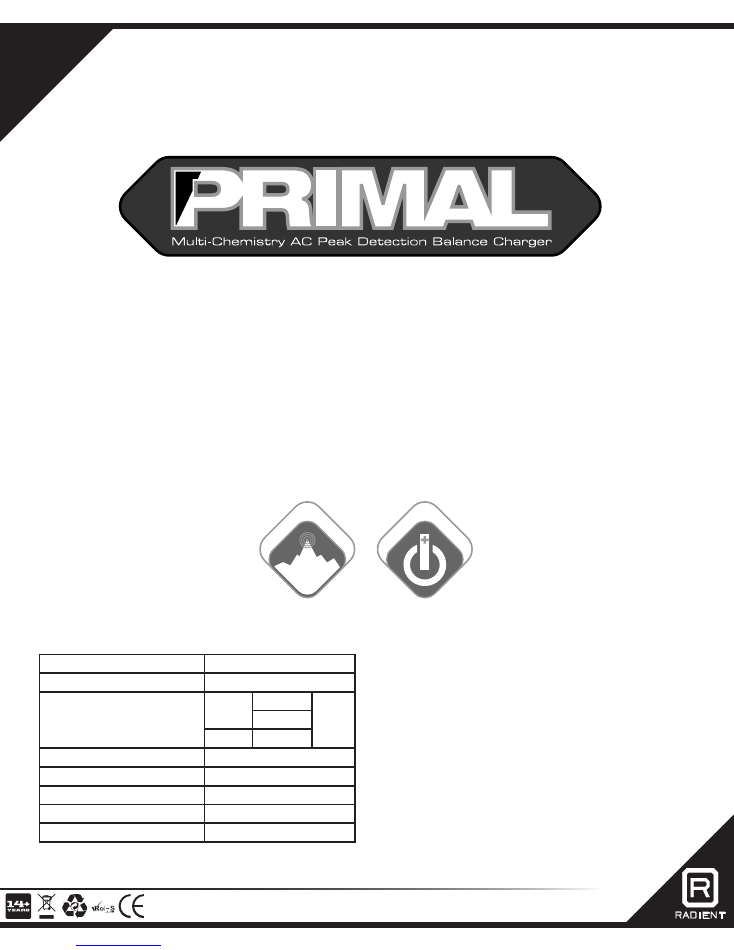
Simple
•
Capable
•
Safe
Safe
Peak
Safe
Start
WWW.RADIENTRC.COM
RDNA0001
• Entire contents ©2014 Radient RC.
• Before using your product, review all documentation and inspect the
products carefully. If for some reason you decide it is not what you
wanted, then do not continue with unpacking, setup or operation
of your product. Your local hobby dealer cannot accept a product
for return or exchange after partaking in actions that produce wear
and tear.
• Product specifications are subject to change without notice. Due
to ongoing development, the actual product may vary from images
shown.
• This product contains chemicals known to the State of California to
cause cancer and birth defects or other reproductive harm.
• This product is not a toy! (14+) Recommended for ages 14 and up.
Adult supervision required for ages under 18 years old. Contains
small parts, keep out of reach of children 3 years of age and
younger.
Input power
AC, 100-240V, 50-60Hz
Internal DC switching power supply 50W with cooling fan
Charge current rate
LiPo
2s (7.4V)
0.5-4A
3s (11.1V)
NiCd/MH 1-8 cell
Current drain for balance port
300mAh
Output connector
TAM style, Mini/Micro adapter
Integrated balance plug
JST-XH (2s-3s)
Weight
350g
Dimensions
161x105x60mm
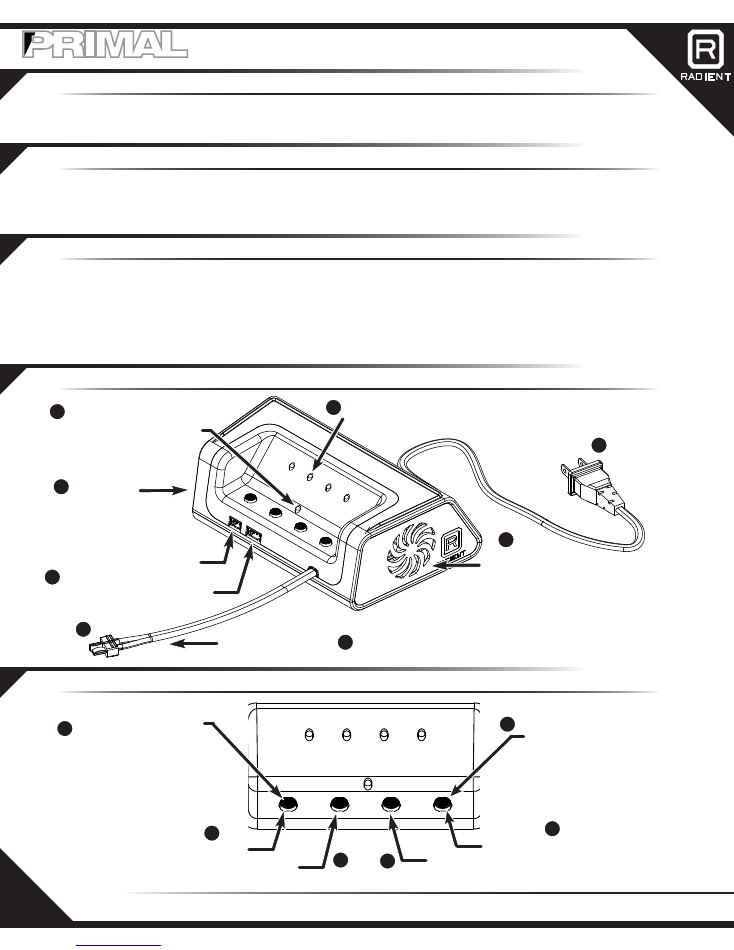
PACKAGE CONTENTS
COMPATIBLE BATTERY TYPES FOR USE WITH YOUR CHARGER
UNBOXING
INTRODUCING THE PRIMAL CHARGER
THE CONTROL PANEL
2
MULTI-CHEMISTRY AC PEAK DETECTION BALANCE CHARGER
• Nickle Cadmium (NiCd)
› 1 (1.2V) - 8 (9.6V) cells
• Nickle Metal-Hydride (NiMH)
› 1 (1.2V) - 8 (9.6V) cells
1. Remove the charger from the box.
a. Ensure the plug is compatible with your battery.
i. NOTE: There are many different types of battery plugs on the market. If yours does not fit the standard supplied plugs, please
visit your local hobby dealer to purchase the correct adapter.
2. Read charging instructions and understand all warnings and cautions before proceeding.
a. This product is not a toy and should not be charged, operated, or maintained without supervision of an adult.
b. It is necessary to follow all manufacturer’s charging instructions per each battery type.
• [1] Primal Charger
• [1] HCT-Plug to Mini/Micro plug adapter
• [1] Documentation package
• Lithium Polymer (LiPo)
› 2s (7.4V) - 3s (11.1V) cells (series configuration)
CHARGE STATUS LED (RED/GREEN)
CHARGE CURRENT LEDs (RED, 0.5-4A)
LiPo JST-XH 2s Balance Port
LiPo JST-XH 3s Balance Port
AIR VENT
(KEEP CLEAR)
MAIN CHARGE LEADS
9
COOLING FAN
(KEEP CLEAR)
11
7
2
10
8
1
11
LiPo CHEMISTRY BUTTON
BUTTON TO HOLD WITH SAFE START BUTTON
TO BEGIN LIPO CHARGE
BUTTON TO HOLD WITH SAFE START
BUTTON TO BEGIN NIXX CHARGE
CHARGE CURRENT SELECT
SAFE START
NiCd or NiMH (NiXX) CHEMISTRY BUTTON
3
3
3
4
3
5
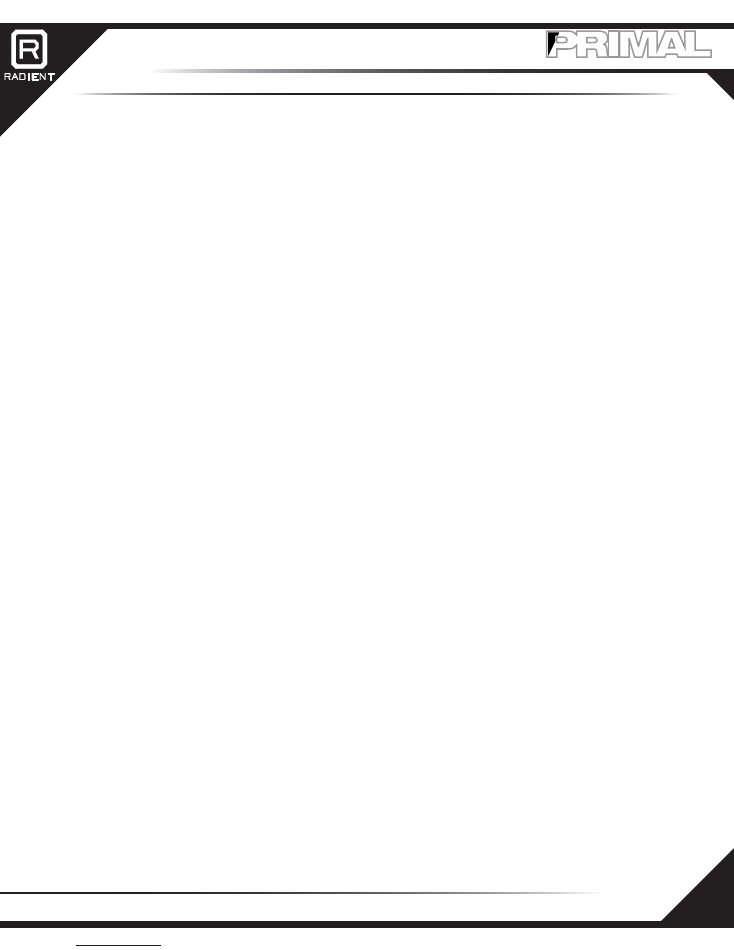
PHYSICAL FEATURES
3
Simple • Capable •
Safe
1. Status LED
a. OFF: Not in use
b. SOLID RED: Charging
c. FLASHING GREEN: Peak detection active
d. NiXX: the charger has entered Delta-Peak mode, the battery is approximately 90% charged
e. LiPo: the charger has entered CV charging mode, the battery is approximately 80% charged
f. SOLID GREEN: Charge cycle complete
g. ERROR
i. FLASHING RED/GREEN: Charger is in thermal protection mode. Charging current has been reduced to minimum to allow for
the charger to cool back down to normal operating temperatures. When charger has cooled, normal charging will resume. If
you see this error, direct a cooling fan at the charger, with the air blowing away from yourself or any flammable objects.
h. FLASHING RED:
i. Connection problem or damaged battery (check for proper polarity and balance plug connection.
ii. Input power is out of operating limits.
2. Amp LEDs
a. LEDs flash RED indicating 0.5A setting.
b. LEDs glow solid RED indicating the selected charge current.
3. Safe Start
a. Pressing simultaneously for 3 seconds with the LiPo OR NiXX button is the only way to start a charging cycle.
b. Press to
STOP
charging at any time while charging.
4. Amps
a. Press repetitively to cycle through available charge rates for use with the connected battery. Stop pressing when the LED above the
desired charge rate is illuminated.
5. LiPo
a. Pressing simultaneously for 3 seconds with the ‘Safe Start’ button is the only way to start a charging cycle.
6. NiXX
a. Pressing simultaneously for 3 seconds with the ‘Safe Start’ button is the only way to start a charging cycle.
7. 2s-3s JST-XH Balance ports.
a. Connected your LiPo balance plug to the appropriate port to enable LiPo balance charging.
i. If your battery has a different connector, do not try to modify your connector or the charger. Visit your local hobby dealer and
purchase a Radient Primal Universal Balance Adapter (RDNA0003) for use with your balance plug.
8. Main charging lead
a. Connect to the main charge leads of your battery using the appropriate connector type. Visit your local hobby dealer for assistance if
the plug on your battery and charger do not match.
b. WARNING: Never try to force connectors together.
9. Charge plug adapter, High Current T-Plug
a. Connect the main charge leads of your charger to the battery for batteries using HCT compatible plugs.
b. Connect the main charge leads of your charger to the included micro/mini adapter to charge batteries with the micro/mini plug
installed. Visit your local hobby dealer for assistance if the plug on your battery and charger do not match.
c. WARNING: Never try to force connectors together.
10. AC input plug
a. For use with 2 and 3 prong grounded US receptacles (plugs) supplying 100-120V @60Hz AC power.
11. Cooling fan and vents
a. Always keep clear and never stick anything into the charger through these or any other holes in the case.
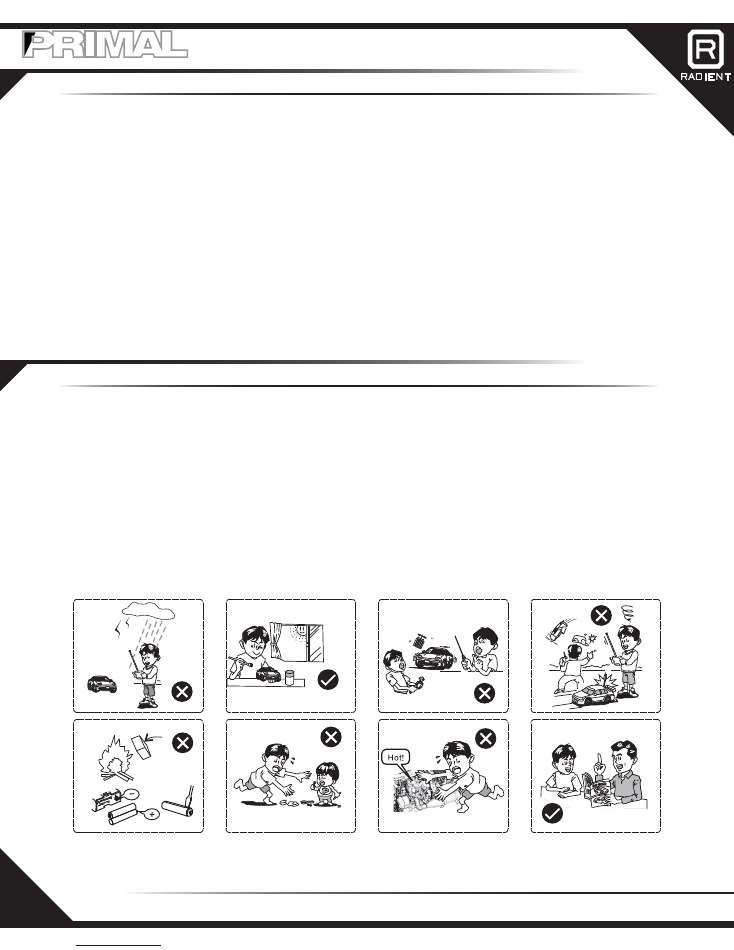
GENERAL CHARGING PRECAUTIONS
TIPS FOR SAFELY OPERATING YOUR CHARGER
4
MULTI-CHEMISTRY AC PEAK DETECTION BALANCE CHARGER
Although great for first time users, Radient RC products are indeed advanced and sensitive electronics that could result in injury if used improperly.
Always use caution and common sense as failure to operate your Radient RC product in a safe and responsible manner can result in damage to the
product or other properties. Therefore this product is not intended for use or maintenance by children without direct adult supervision. Radient RC,
and your local hobby dealer shall not be liable for any loss or damages, whether direct, indirect, special, incidental, or consequential, arising from
the use, misuse, or abuse of this product or any product required to operate or maintain it. Following are some general tips that will help increase
the safe operation and enjoyment of using your charger.
• Do not operate your charger in direct sun light, rain, electrical, or thunder storms.
• The charger should never be connected to a battery without being connected to an input power source.
• Never operate your charger where input power is highly unstable.
• Never attempt to charge a non-rechargable battery or battery type that is not compatible wit this charger
• Operate in a dry, open environment away from property, and cars (never run into the street for any reason).
• Always disconnect the battery from the charger after charge is complete.
• Never connect the battery to the charger when the charger is powered off. The charger should always be powered on before connecting the
battery.
• Never stick anything into the charger case due to risk of electrical shock or interference with the cooling fan
• Always allow batteries to completely cool before charging.
› NOTE: Only use genuine replacement or aftermarket parts available from your local dealer to ensure proper operation of your Radient
RC product.
• Avoid charging on or around flammable items.
• Never attempt to charge a swollen or damaged battery.
• Never leave the battery unattended while charging.
• Never operate the charger without adult supervision.
• Never charge a warm battery, always allow the battery to cool to room temperature before charging.
• Never drop the charger or battery.
• Inspect the battery and charger before use. Never charge a battery or operate a charger if the wire or connector has been damaged or if the
battery has experienced a short circuit.
• Incorrect use of the battery, connections, or charging equipment can cause personal injury or property damage.
• Never allow batteries or charger to come in contact with moisture at any time; avoid environments with high humidity.
• Disconnect input power and battery immediately if the battery, connector, or charger becomes hot or changes form during use.
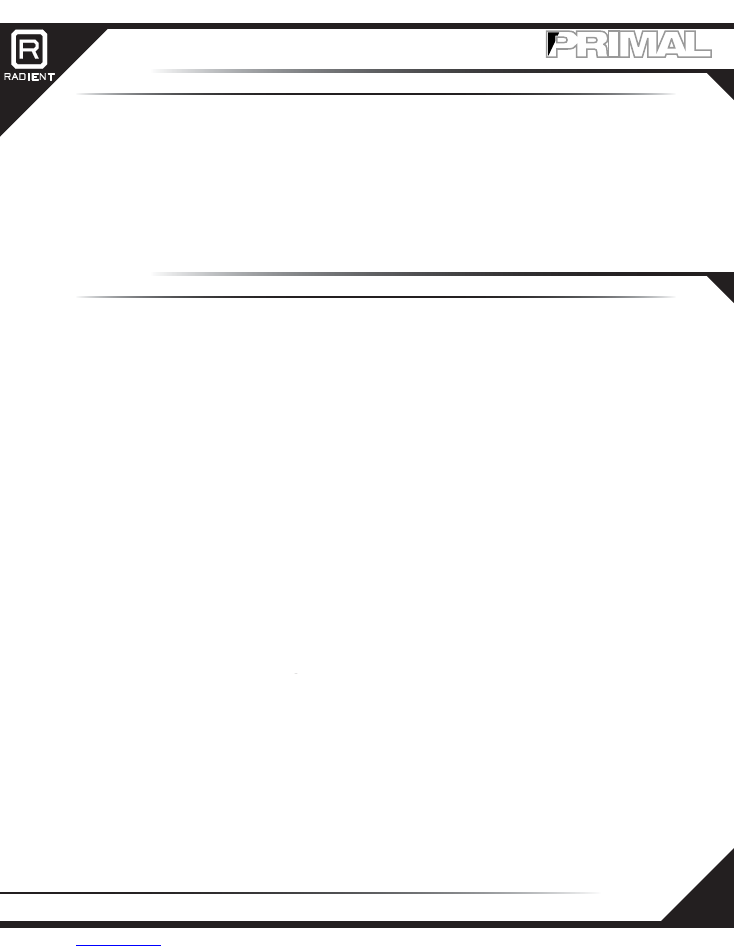
THIS PART IS REALLY IMPORTANT, PLEASE READ AND UNDERSTAND IT
LETS GET CHARGING
5
Simple • Capable •
Safe
Now that you are familiar with the charger, its features, and general precautions of what not to do and some of what to do, we should get started
charging your first battery. Just a reminder...set some time aside so you
DON’T
have to walk away and
STOP THE CHARGER, MID
CHARGE
since you should never leave the charger unattended while charging. Finally, confirm the battery chemistry type, capacity, voltage and
cell count of the battery you will charge and ensure all connector plugs are compatible. Here are the basics of what you will be doing.
1. Plug the charger into a properly grounded AC wall plug.
2. Plug the battery into the charger and place the battery on/in a non-flammable surface/container and away from any flammable objects.
3. Follow the appropriate charge instructions for your battery chemistry type listed on the following page.
4. Unplug the battery from the charger when the charge is complete.
5. Remove charger from wall plug when not in use.
a. NOTE: Only use batteries with labels that are legible and clearly state the capacity, cell count (or voltage), and chemistry type as
either NiCd, NiMH, or LiPo.
WARNING:
The Radient Primal charger has the capability of charging both LiPo and NiCd/NiMH (NiXX) batteries which require significantly dif-
ferent charging modes. It is extremely important to choose the correct charging mode when charging your batteries. Choosing the wrong charging
mode can cause fire or explosion. Be sure to properly identify the battery chemistry, voltage and capacity of every pack before attempting to charge
it to ensure the correct settings. Some LiPo battery packs are designed to look like NiXX battery packs. One indication of a LiPo battery is the pres-
ence of a balance plug either exiting the battery with small wires and small plug on the end or a small female plug embedded into the end of the
battery pack. If you are unsure of the battery type you are attempting to charge; please consult your local hobby dealer for assistance.
To help ensure the correct charging mode is used when charging your batteries, the charger is equipped with Safe Start technology. Safe Start is
a start sequence technology used to deter the use of the incorrect charging mode for batteries of different chemistry. When battery packs are con-
nected properly per chemistry the system is very robust; however if some batteries are improperly connected it is possible to charge LiPo batteries
in NiXX mode, exactly what you should NEVER do, so caution is always required when operating the charger. Safe Start is used by requiring the
simultaneous pressing of both the Safe Start button and the appropriate charge mode button for 3 seconds to begin the charge cycle.
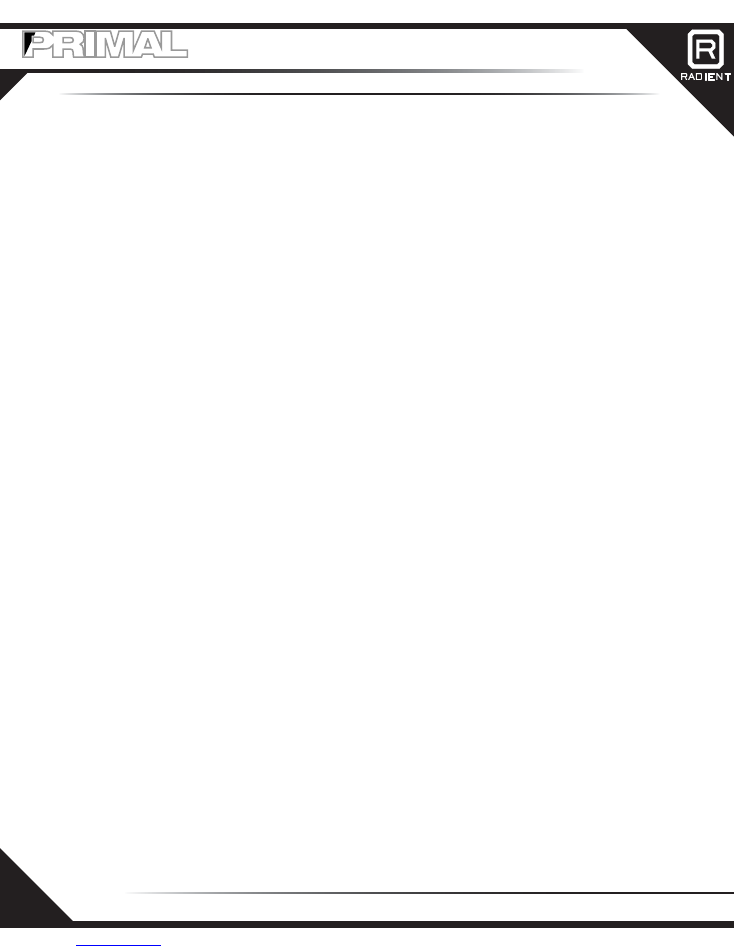
CHARGING A LiPo BATTERY
6
MULTI-CHEMISTRY AC PEAK DETECTION BALANCE CHARGER
The Radient Primal charger supports charging of LiPo batteries using Constant-Current Constant-Voltage (CC-CV) charge mode for 2s-3s cell
configurations with available charge current range from:
• 0.5-4 Amps for 2s (7.4V) configuration
• 0.5-4 Amps for 3s (11.1V) configuration
› NOTE: Your charger is equipped with a safety shut-off timer set to 120min. Charging of batteries with capacity higher than 5000mAh
may require a greater charge time and thus require more than one charge cycle to achieve full charge. It is always recommended to
allow your battery to cool to room temperature before charging either the first or second time.
To charge a LiPo battery in CC-CV charge mode, perform the following steps:
1. Connect your LiPo battery’s balance plug connector to either the JST-XH (2s or 3s) balance port built into the charger or into a connected
external balance adapter board (RDNA0003 for example).
a. NOTE: Charging of LiPo batteries on LiPo mode without connecting the balance connector is not supported. As an added feature
to our Safe Start technology, if a balance plug is detected by the charger, use of the NiMH charge mode is disabled and cannot be
circumvented.
2. Connect the main charging leads to your battery.
a. NOTE: it is critical that the battery always be connected with the correct polarity, Negative (-) = Black, and Positive (+) = Red. Only
connect Like color and symbol together.
3. Select the appropriate charge current for your battery by pressing the ‘Amps’ button repeatedly until the desired charge current is selected,
indicated by the row of glowing RED LEDs. For 0.5A, the 1A LED will flash, for 1A, only the 1A LED will glow, for 1.5A, the 1A LED will glow
and the 2A LED will flash, for 2A, both the 1A and 2A LEDs will glow. The pattern continues through 4A at which time another button press
will cycle around to 0.5A again.
a. WARNING: Selecting the appropriate charge current is critical to the safe charging of your batteries.
To achieve the safest operating conditions and longest life from your batteries it is recommended to
charge your batteries at no more than 1C. See the Index at the back of this manual for charge rate
calculations.
i. Note: Although you may select charge currents up to 4A, the maximum final charge current may be reduced as needed to
keep the charger operating within safe limits. Typically this occurs when charging a 3s LiPo at 4A.
01). Example: A 3s LiPo may start to charge at 4A but as the voltage of the battery increases the charge current will
reduce to approximately 3A.
ii. Utilizing this method of charge current control enables the charger to always try to charge your battery as close as possible
to the setting you specify, while keeping the system within safe operating limits.
b. You have 30 seconds from the last ‘Amps’ button press, to start the charge cycle. After 30 seconds the charger will reset to the
default of 1A charge current.
4. Press both the Safe Start and LiPo buttons at the same time and hold for 3 seconds to start the charging cycle. The center ‘Status’ LED will
change to solid RED.
a. NOTE: If the LED begins to flash RED or if the charger is unresponsive to your input, see the troubleshooting guide at the back of this
manual.
5. Near the end of charge completion the LED will flash GREEN, indicating the charger has entered Constant Voltage (CV) mode, the battery is
typically 80% charged at this point.
6. When the charge is complete, the LED will glow solid GREEN. The LED will glow solid GREEN until the battery or AC power is disconnected.
a. NOTE: If the charger encounters an error throughout the start or charging process, the center ‘Status’ LED will flash RED. See the
trouble shooting guide at the back of this manual for possible solutions.
7. Pressing the ‘Safe Start’ at any time while charging will STOP the charge cycle.
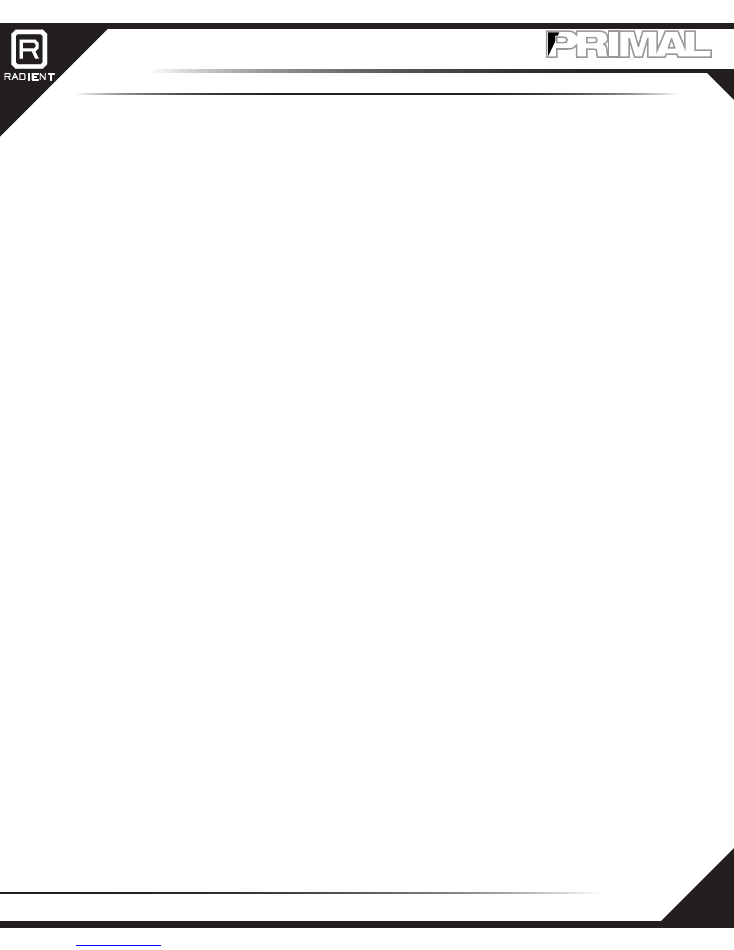
CHARGING A NiCd/NiMH (NiXX) BATTERY
7
Simple • Capable •
Safe
The Radient Primal charger supports charging of NiXX batteries from 1-8 cell series configurations with a delta peak value of 8mV and available
charge current range from:
• 1-4 Amps for 1-8 cell (1.2V-9.6V) configurations
› NOTE: Your charger is equipped with a safety shut-off timer set to 120min. Charging of batteries with capacity higher than 5000mAh
may require a greater charge time and thus require more than one charge cycle to achieve full charge. It is always recommended to
allow your battery to cool to room temperature before charging either the first or second time.
To charge a NiXX battery in Delta-Peak charge mode, perform the following steps:
›
WARNING:
Ensure your battery is truly a NiCD or NiMH battery. Some LiPo battery packs are designed
to look like NiXX battery packs. If you are unsure of the battery type you are attempting to charge;
please consult your local hobby dealer for assistance.
› NOTE: As an added feature to our Safe Start technology, if a balance plug is not detected by the charger, use of the LiPo or LiFe
charge modes are disabled. By the same logic, if a balance plug is detected the use of NiMH and NiCd charge modes are disabled.
This cannot be circumvented.
1. Connect the main charging leads to your battery.
a. NOTE: it is critical that the battery always be connected with the correct polarity, Negative (-) = Black, and Positive (+) = Red. Only
connect Like color and symbol together, any other form of connection may cause fire or explosion.
2. Select the charge appropriate charge current for your battery by pressing the ‘Amps’ button repeatedly until the desired charge current is
selected, indicated by the row of glowing RED LEDs. or 0.5A, the 1A LED will flash, for 1A, only the 1A LED will glow, for 1.5A, the 1A LED
will glow and the 2A LED will flash, for 2A, both the 1A and 2A LEDs will glow. The pattern continues through 4A at which time another
button press will cycle around to 0.5A again.
a. WARNING:
Selecting the appropriate charge current is critical to the safe charging of your batteries.
To achieve the safest operating conditions and longest life from your batteries it is recommended to
charge your batteries at no more than 1C. See the Index at the back of this manual for charge rate
calculations.
i. Note: Although you may select charge currents up to 4A, the maximum final charge current may be reduced as needed to
keep the charger operating within safe limits. Typically this occurs when charging a 8 cell NiXX at 4A.
01). Exp: A 8 cell NiMH may start to charge at 4A but as the voltage of the battery increases the charge current will
reduce to approximately 3A.
ii. Utilizing this method of charge current control enables the charger to always try to charge your battery as close as possible
to the setting you specify, while keeping the system within safe operating limits.
b. NOTE: You have 30 seconds from the last ‘Amps’ button press, to start the charge cycle. After 30 seconds the charger will reset to
the default of 1A charge current.
3. Press both the Safe Start and NiXX buttons at the same time and hold for 3 seconds to start the charging cycle. The center ‘Status’ LED will
change to solid RED.
a. NOTE: If the LED begins to flash RED or if the charger is unresponsive to your input, see the troubleshooting guide at the back of this
manual.
4. Near the end of charge completion the LED will flash GREEN, indicating the charger has entered Delta-Peak (dV) mode.
5. When the charge is complete, the LED will glow solid GREEN. The LED will glow solid GREEN until the battery or AC power is disconnected.
a. NOTE: If the charger encounters an error throughout the start or charging process, the center ‘Status’ LED will flash RED. See the
trouble shooting guide at the back of this manual for possible solutions.
6. Pressing the ‘Safe Start’ at any time while charing will STOP the charge cycle.
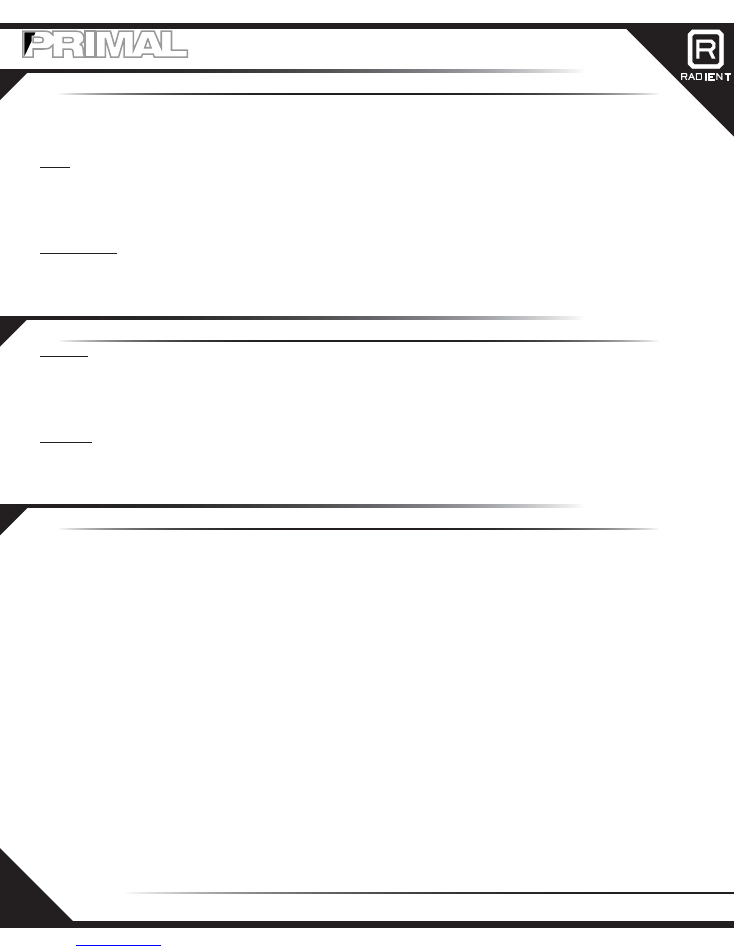
GENERAL CARE AND MAINTENANCE
STORAGE AND DISPOSAL
RELATED SPARE PARTS LIST
8
MULTI-CHEMISTRY AC PEAK DETECTION BALANCE CHARGER
WARNING: This charger contains a built in AC to DC converter which can store electrical power for a short time
after disconnection from the AC input power source. Always unplug the charger from both input power and output
charging leads before performing any cleaning or maintenance to prevent electric shock. It is advisable to wait at
least 1 minute before starting your cleaning or maintenance.
Care:
• Always use clean, dry cloth or soft bristle brush to clean your equipment.
• Never use chemical cleansers to avoid damage to the sensitive electronics and plastics.
• Before every use, inspect the input and output power cords and plugs and discontinue use if there are any signs of damage.
› Contact your local hobby dealer or Radient RC Customer Support for assistance with repair needs.
› NOTE: Continued use of a damaged battery or charger will void the warranty and could cause personal injury and property damage.
Maintenance:
• Periodically use compressed air to blow out dust that has been trapped inside the charger to help prevent excessive heat due to dust build
up.
›
WARNING: Always wear eye protection when using compressed air to clean your charger.
› NOTE: Ensure the charger is disconnected form input power and any battery before performing any care or cleaning procedures.
Storage:
• There is a cord wrap feature located on the bottom of your charger. Use it to coil the unused length of input power cord.
› NOTE: Never “kink” (or bend sharply) any electrical wires. Doing so may damage the internal electrical wire even if the outside
appears undamaged.
• Never store the charger (or your batteries) in direct sunlight for extended periods of time.
• Since every battery and manufacturer is different, refer to the storage instructions from your battery manufacturer for proper information.
Disposal:
• Your product and the various batteries it is intended to be used with are considered electronic waste and should never be discarded in
standard garbage containers. Please visit your local hobby dealer and use the FREE battery disposal center for proper disposal/recycling of
batteries. Consult your local city waste disposal center for information on disposal of electronics other than batteries.
• Please do your part to protect our environment.
RDNA0003 ..................PRIMAL UNIVERSAL LIPO BALANCE ADAPTER BOARD (2-S) ....................................................................................................
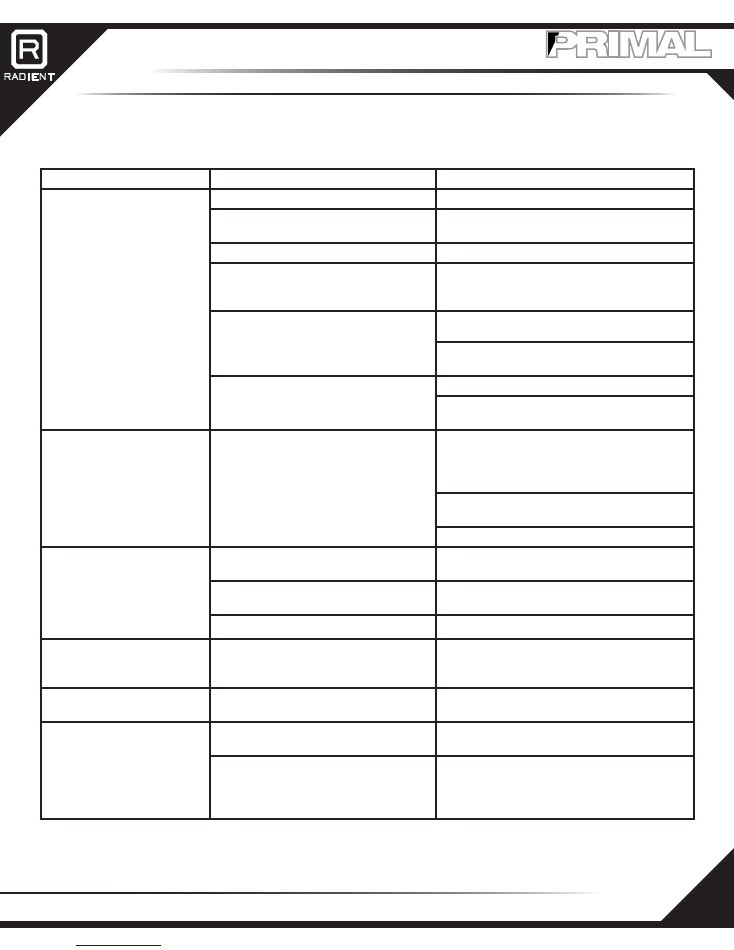
TROUBLESHOOTING GUIDE
9
Simple • Capable •
Safe
Problem / Symptom
Possible Cause
Possible Solution
Status LED is flashing RED
Battery voltage too low
Battery may be dead and in need of replacement
Battery voltage too high
Battery voltage could already indicate a full charge,
attempt to use your battery then charge again.
Input voltage is too low
Check for stable input power with proper voltage
Reverse polarity
Check battery connection and ensure red wires are
connected to red wires and black wires are connected
to black wires
Balance plug not connected properly when
attempting to balance charge LiPo battery
Check balance plug is properly connected
Ensure the correct charge mode is being used for your
battery type
Balance plug connected when trying to charge
NiXX battery
Check balance plug is not connected
Ensure the correct charge mode is being used for your
battery type
Status LED is flashing Red/Green
The charger has over-heated and reduced the
charge current to minimum. Your battery will
continue to charge but at a very slow rate until
the internal temperature of the charger is back
down into operational limits
Stop charging, unplug your charger from all con-
nections and blow compressed air through the side
vents to remove dust. See the ‘General Care and
Maintenance” section of this manual.
Remove charger from direct sun light or area of high
ambient temperature and allow to cool
Direct a cooling fan onto the charger
The charger is unresponsive to
starting when using Safe Start
sequence
The charge mode is incorrect for the connected
battery
Check battery connections and confirm battery type
and charge mode
The buttons are not being depressed at the
same time for long enough
Ensure you are pressing down 2 buttons simultane-
ously for at least 3 seconds
There is a connection problem
Check input and output connections
The charger resets charge current
to 0.5A automatically
This is a built in safety feature and is executed
after 30 seconds of standby or charge comple-
tion
Be sure to start your charge within 30 seconds of your
last button press when selecting the charging current
(Amps button).
The charger is unresponsive to
any input
The input power is unstable
Check input power connections and appropriate volt-
ages are present
The fan is not working
Charger is not in use
Start a charge and pay attention as the charge nears
completion.
The fan is controlled by the internal microcon-
troller and will only come on when needed,
however it could still become damaged.
Look for the charger to flash the red/green error code
indicating it has reached an internal temperature that is
too high, if the fan does not come on, it is damaged or
could have become unplugged. Contact support.
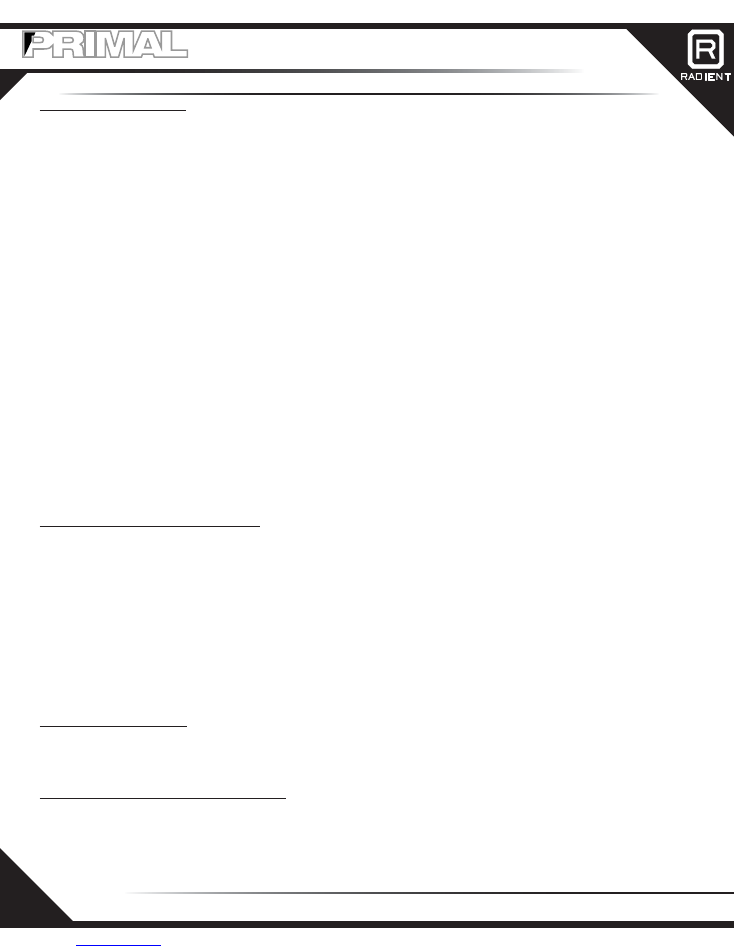
INDEX
10
MULTI-CHEMISTRY AC PEAK DETECTION BALANCE CHARGER
Understanding C Ratings:
Many battery manufacturers do not list the definition of or explain the purpose of C ratings and how to use that information. For LiPo batteries there
is typically listed both a C rating for charging and discharging of the batteries. You must use caution that you calculate your charge rate based on
the charge C rating and not the discharge C rating.
• Charge Rate Calculation
› The charge C rating of a battery refers to a ratio between the battery’s capacity and the maximum safe charge current as determined
by each manufacturer for each battery. This value is typically listed in the lower ranges between 1C-5C. It signifies the maximum
current the battery should be charged at in a multiple of the capacity of the battery cells (on a per cell basis, not per pack basis).
» For example: if a battery cell is 2000mAh and the charge C rating is listed at 2C, the maximum charge current that should be
used with this battery is equal to 2000 x 2 = 4000mA = 4.0A.
» NOTE: 1000mAh = 1Ah. For simplified annotation, although charge rates are actually units of Ah, we refer to them as A only.
Thus 1Ah = 1A.
» Since the Primal charger only increments in values of 1A, if the calculated maximum charge rate is a decimal value (4.4) it is
highly recommended to round this value down to the nearest whole number and use that as the
maximum
charge rate, but
not necessarily the
best
charge rate option.
» If the calculated charge rate is over the maximum capability for this charger, you can simply use the maximum allowed.
› Radient RC recommends charging at 1C for the maximum cycle life of your batteries.
› Always check the instructions provided with your batteries for proper charge and care. Those instructions should over-ride these
since they pertain to the particular battery that you have and this is a general statement.
• Discharge Rate Calculation
› The discharge C rating of a battery refers to a ratio between the battery’s capacity and the maximum safe discharge current as
determined by each manufacturer for each battery This value is typically listed in the higher range from 15C upwards. It signifies the
maximum current the battery should be discharged at in a multiple of the capacity of the battery cells (on a per cell basis, not per
pack basis).
» For example: if a battery cell is 2000mAh and the discharge C rating is listed at 30C, the maximum discharge charge current
that should be used with this battery is equal to 2000 x 30 = 60000mA = 60A. This means you can continuously discharge
this battery at a rate of 60A per hour without damage.
» Since the Primal charger does not discharge, this information is only for reference in helping you understand the terminology
of the battery industry.
Termination Voltages (Peak Detection):
• LiPo Batteries: The peak detection of a LiPo battery works by increasing the voltage of the battery pack to a specified range. The goal of the
charger is to increase the voltage of the battery into this range while injecting the most mAh into the battery as possible. The charge cycle
terminates when this value is reached.
› The nominal voltage of a LiPo battery cell is listed at 3.7V.
› The Primal charger will terminate the charge of a LiPo battery pack when it measures a voltage of 4.18-4.2V per cell.
› For a 2s 7.4 nominal voltage battery pack, the termination voltage would be 2 x 4.2 = 8.4V.
• NiXX Batteries
› The nominal voltage of a NiXX battery cell is listed at 1.2V.
› The Primal charger will terminate the charge of a NiXX battery pack when it measures a maximum voltage of the battery pack in a
specified range and then also measures a drop in that voltage of 8mV.
› The maximum voltage a battery pack reaches changes during the life of the battery (increasing with age). The characteristic
behavior of the voltage drop remains the same however thus allowing the charger to continue to detect a “peak” voltage (maximum
voltage - 8mV) regardless of age.
Power Rating (Watt-hour):
› Some products state a recommended Watt hour rating for a battery to be used with that product. The Watt hours can be approxi-
mately calculated knowing the battery capacity and the voltage.
» For Example: if a battery is 2000mAh and the voltage is 8.4V the Watt Hours (Wh) is equal to 2000 x 8.4 = 16,800mWh =
16.8Wh.
Recommended Discharge Voltage Cut-offs:
• For maximum cycle life and safety, LiPo batteries should never be discharged below 3.3V per cell when discharged at a rate of 1-4C. For
this reason, many electronic speed controllers have a special “LiPo Mode” which activates a cut-off of power when the ESC measures the
battery voltage in a dangerous range.
• For maximum cycle life and safety, NiXX batteries should never be discharged below 0.9V per cell when discharged at a rate of 1-4C. The
use of an ESC low voltage “cut-off” mode is not necessary with NiXX batteries.
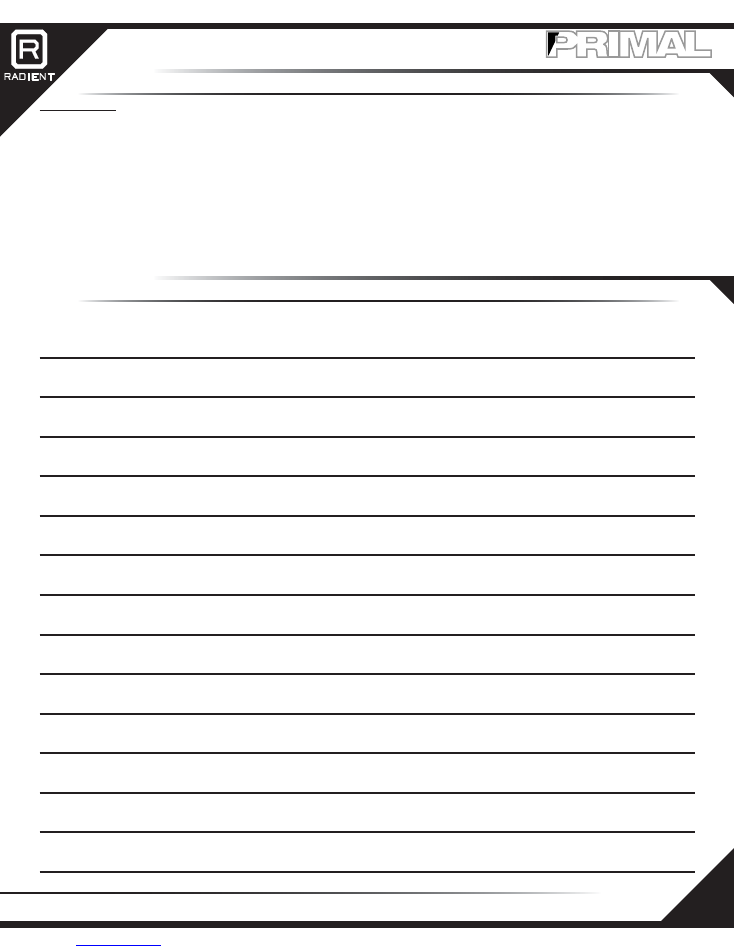
CHARGING A NiCd/NiMH (NiXX) BATTERY
NOTES
11
Simple • Capable •
Safe
Storage Voltages:
• Although the Primal charger does not offer discharge capabilities it is important to understand this information about your batteries since it
is critical to both the safety of the battery and the cycle life.
› Always consult the battery manufacturer’s documentation for storage information specific to that battery.
»
WARNING:
You should NEVER store LiPo batteries at full charge for more than a few hours at
most (and they should be stored at temps of 40-75 degrees Fahrenheit whenever possible to help
prevent swelling and/or loss of performance/capacity).
› LiPo batteries should be charged (or discharged depending on their state prior to storage) to approximately 50% of their rated
capacity (approximately 3.85V per cell). The storage time at this voltage should not exceed 6 months and a use cycle and return to
storage mode is recommended every 3 months.
› The storage voltage of NiXX batteries is not as critical as LiPo but they should be stored in cool conditions and at a low cell voltage to
prevent memory buildup and loss of capacity and performance.
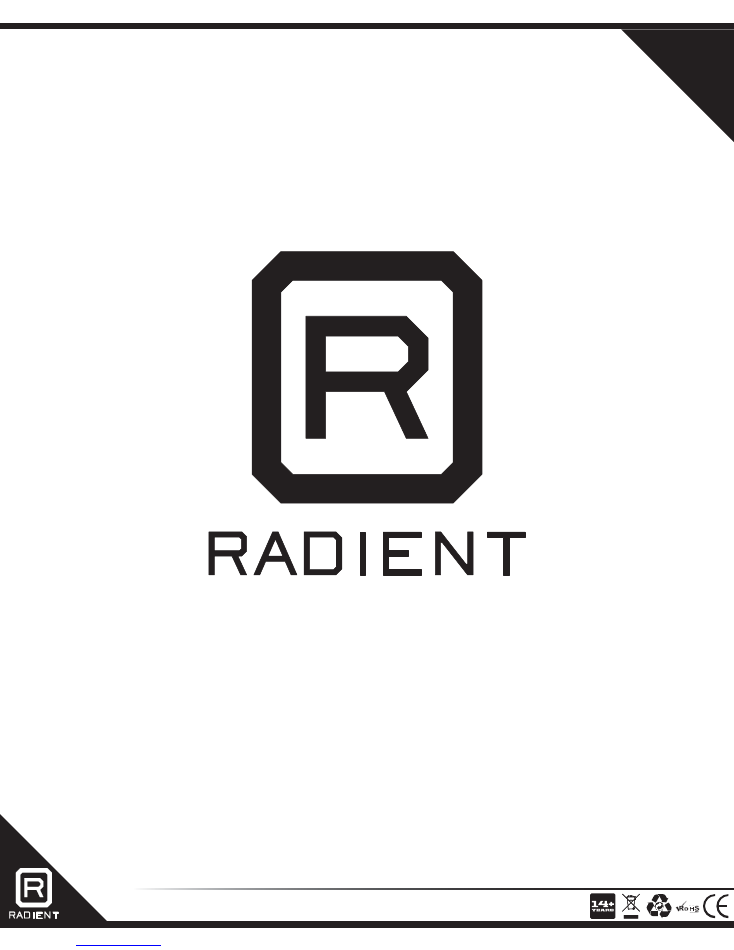
WWW.RADIENTRC.COM
000044-002 (REV A)